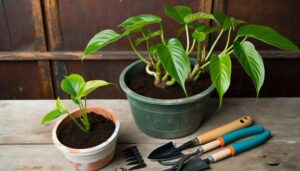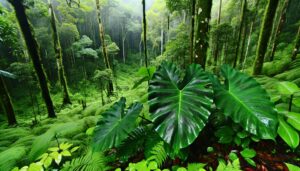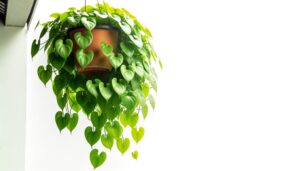What Is the Origin of the Philodendron Micans?
Philodendron micans, renowned for its velvety, heart-shaped leaves, is native to the tropical rainforests of Mexico, the Caribbean, and Central America. It thrives under dense canopy conditions where high humidity and warm temperatures prevail.
First documented by botanists in the late 19th century, P. micans exhibits adaptive climbing habits enabled by aerial roots and thrives in low-light environments essential for its survival.
Detailed botanical studies have revealed its unique physiological and reproductive adaptations. This fascinating epiphytic species continues to be a subject of interest in botany and horticulture.
For further insights into its ecological significance and cultivation techniques, continue exploring.
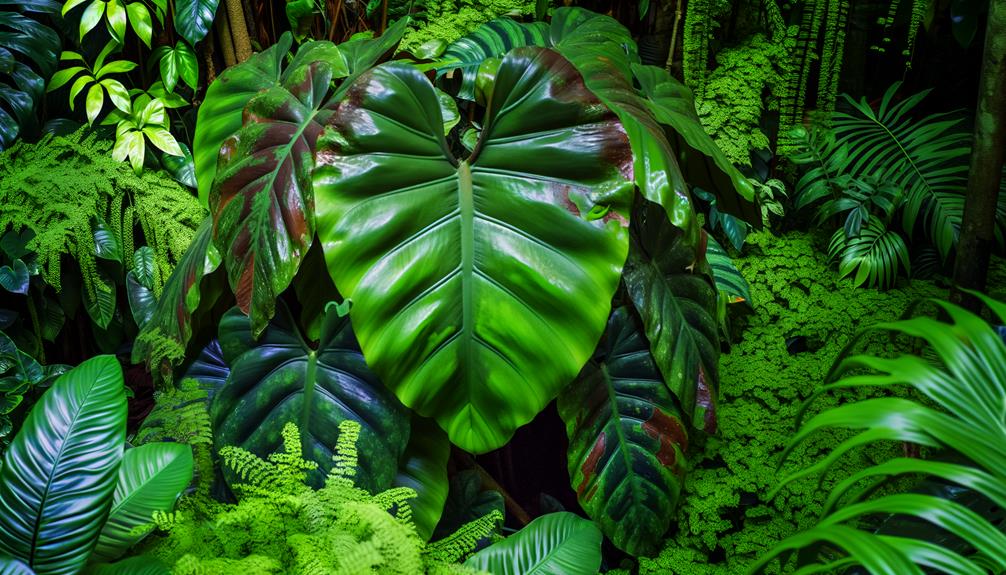
Key Takeaways
- Philodendron micans is native to the tropical rainforests of Mexico, the Caribbean, and Central America.
- It thrives under dense canopies in high humidity and warm temperatures.
- The plant was first documented by botanists in the late 19th century.
- It exhibits a unique climbing habit, using aerial roots for nutrient absorption.
- Its velvety, heart-shaped leaves are adapted to low-light environments.
Native Regions

The Philodendron micans is native to the tropical rainforests of Mexico, the Caribbean, and Central America. This region, characterized by high humidity and warm temperatures, provides an ideal habitat for the species. The plant thrives under the dense canopy, where indirect sunlight filters through, creating a dappled light environment.
Its native range includes various microclimates, allowing the Philodendron micans to adapt to diverse moisture levels and soil types. These ecosystems are rich in organic matter, facilitating nutrient uptake critical for its growth.
The lush foliage of the Philodendron micans, with its velvety, heart-shaped leaves, is a common sight climbing tree trunks and sprawling across the forest floor, illustrating its adaptability and resilience in these biodiverse regions.
Discovery
Botanists first documented the Philodendron micans during an expedition in the late 19th century, noting its unique morphological features and its prevalence in the understory of tropical rainforests. The discovery highlighted the species' velvety, heart-shaped leaves and its adaptive climbing habit, which allows it to thrive in low-light environments. This observation was pivotal in understanding the plant's ecological niche and its role within the rainforest ecosystem.
| Feature | Observation |
|---|---|
| Leaf Structure | Velvety, heart-shaped leaves |
| Habitat | Understory of tropical rainforests |
| Adaptive Traits | Climbing habit, thrives in low light |
Such detailed documentation laid the foundation for subsequent botanical studies, offering insight into the plant's adaptive strategies and ecological significance.
Early Studies
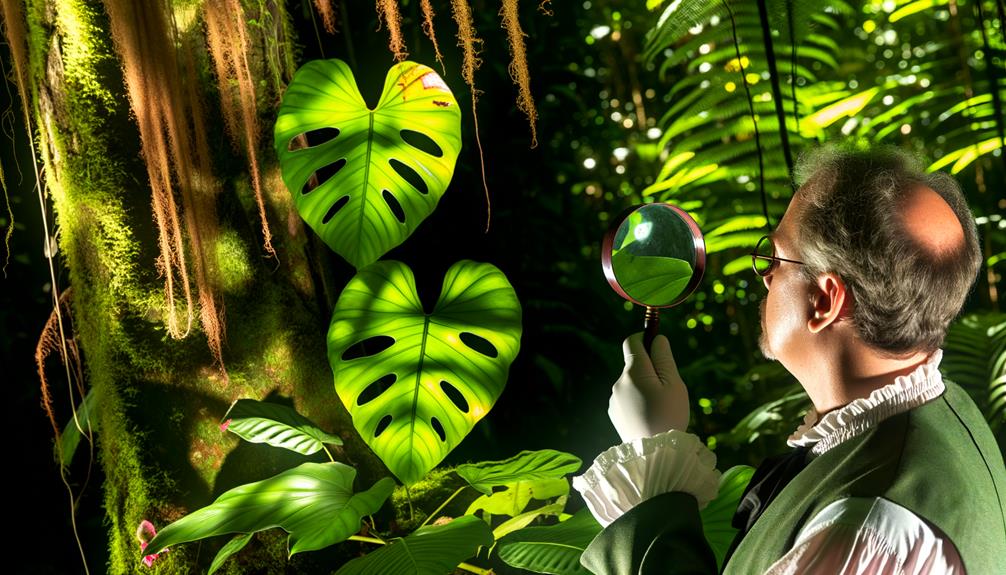
Following its initial discovery, early studies on Philodendron micans focused on its physiological adaptations and reproductive mechanisms within its native habitat.
Researchers meticulously documented its epiphytic growth patterns, observing how it thrives in humid, tropical rainforests by clinging to tree trunks and ascending toward light. Detailed examinations revealed its efficient use of aerial roots for nutrient absorption and moisture uptake.
Moreover, investigations into its reproductive biology highlighted the plant's unique inflorescence structure, which facilitates pollination by specific insect species. These foundational studies provided critical insights into the plant's ecological role and adaptive strategies, laying the groundwork for subsequent research on its propagation and conservation.
The emphasis on empirical data underscored the species' intricate interplay with its environment.
Botanical Classification
Philodendron micans belongs to the family Araceae and is classified within the genus Philodendron, known for its diverse and adaptive species.
Characterized by its velvety, heart-shaped leaves, P. micans exhibits a unique iridescence and coloration that varies with light exposure.
The plant's growth habit is mainly climbing, facilitated by its adventitious roots and vining stems, which enable it to thrive in its native tropical environments.
Family and Genus
The Philodendron micans, belonging to the Araceae family, is classified within the Philodendron genus, which encompasses a diverse array of over 480 species known for their unique foliage and climbing habits. This genus is characterized by its hemiepiphytic growth, where plants initially grow terrestrially before ascending as epiphytes.
Philodendron species exhibit remarkable morphological diversity, adapting to various ecological niches. The Araceae family, commonly known as the arum family, is distinguished by its inflorescence structure comprising a spadix surrounded by a spathe. Philodendrons contribute significantly to the family's reputation for ornamental and horticultural value, and Philodendron micans, with its velvety leaves and robust growth, exemplifies the aesthetic appeal and adaptability inherent to its botanical classification.
Leaf Characteristics
One of the defining features of Philodendron micans is its velvety, heart-shaped leaves, which exhibit a remarkable range of color variations from deep green to bronze, and often display a subtle iridescent sheen. These leaves possess delicate venation patterns, enhancing their visual appeal. Measuring between 7 to 12 cm in length, the foliage is soft to touch, with a slightly trailing habit.
| Characteristic | Description |
|---|---|
| Leaf Texture | Velvety |
| Leaf Shape | Heart-shaped |
| Color Variations | Deep green to bronze |
| Length | 7 to 12 cm |
| Special Feature | Iridescent sheen |
Such attributes not only contribute to the plant's aesthetic appeal but also play a role in its classification within the Araceae family.
Growth Habit
Exhibiting a climbing and trailing growth habit, Philodendron micans belongs to the Araceae family, characterized by its epiphytic and hemiepiphytic nature. This plant demonstrates considerable adaptability, thriving both as a terrestrial and aerial species. Its growth pattern is supported by adventitious roots, which facilitate nutrient absorption and anchorage. The stems possess nodes that produce roots upon contact with a substrate, aiding in its climbing ability.
- Adventitious roots: These roots develop from non-root tissues, enhancing stability and nutrient uptake.
- Epiphytic adaptation: Philodendron micans often grows on other plants, using them as physical support without deriving nutrients.
- Hemiepiphytic behavior: Initially terrestrial, these plants may shift to an epiphytic lifestyle, showcasing remarkable versatility.
This growth habit enables Philodendron micans to colonize diverse environments.
Natural Habitat
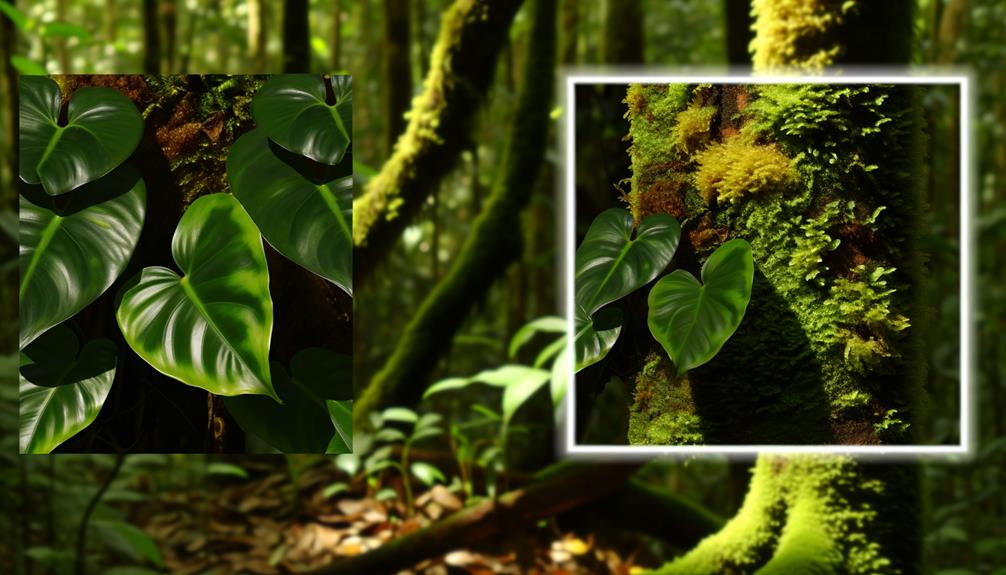
Philodendron micans thrives in the humid, shaded understories of Central and South American tropical rainforests. This epiphytic species is typically found clinging to tree trunks, where it receives diffuse light filtered through the dense canopy above.
The ambient temperatures in these regions range from 20-30°C, with humidity levels consistently above 70%. The rich, organic detritus of the forest floor provides essential nutrients, while the constant moisture promotes vigorous growth.
Philodendron micans' velvety leaves, which exhibit a unique iridescence, are an adaptation to the low-light conditions, maximizing photosynthetic efficiency. These ecological parameters underscore the plant's reliance on stable, high-humidity environments, making it well-suited for similar indoor conditions when cultivated as a houseplant.
Growth Patterns
The growth patterns of Philodendron micans are characterized by a climbing habit facilitated by aerial roots, which enable the plant to anchor itself to support structures as it ascends. These roots are highly specialized and function effectively in humid environments, promoting vertical growth.
The plant exhibits indeterminate growth, allowing it to extend continuously throughout its life cycle. Leaves unfurl in a sequential manner, displaying a unique velvety texture and vibrant coloration.
- Climbing Mechanism: Utilizes aerial roots to secure and climb.
- Indeterminate Growth: Continuous growth pattern without a predefined endpoint.
- Leaf Development: Sequential unfurling with velvety texture.
This climbing nature and robust growth adaptability make Philodendron micans a versatile and visually appealing species in both natural and cultivated settings.
Unique Characteristics

In addition to its climbing mechanism and growth adaptability, Philodendron micans is distinguished by its unique velvety leaf texture and iridescent coloration, which sets it apart from other species in the genus.
The leaves exhibit a velutinous surface, a soft and fine texture akin to velvet, which enhances its ornamental appeal. This tactile quality is complemented by an iridescent sheen that shifts between deep green, bronze, and purple hues depending on light conditions.
The leaf undersides are typically tinged with a reddish or purple hue, contributing to its aesthetic complexity. Moreover, the foliage's heart-shaped morphology and delicate venation patterns are not only visually striking but also indicative of the species' evolutionary adaptations within its native habitats.
Path to Popularity
The Philodendron Micans has gained considerable popularity mainly due to its frequent exposure on social media platforms, where its distinctive velvety foliage appeals to a wide audience.
This species has become a trending choice among houseplant enthusiasts, driven by its aesthetic qualities and relatively low maintenance requirements.
The influence of social media cannot be overstated, as it has greatly amplified the demand and visibility of this appealing plant.
Social Media Influence
Gaining traction through vibrant Instagram posts and YouTube plant care channels, the Philodendron micans owes much of its recent popularity to the visually driven nature of social media platforms. The plant's velvety, heart-shaped leaves, which exhibit a striking iridescence under ideal lighting conditions, have become a favored subject among plant enthusiasts.
Detailed care tutorials and aesthetic plant arrangements have further enhanced its appeal.
- Visual Appeal: The unique foliage of Philodendron micans creates striking images that captivate viewers.
- Educational Content: Numerous influencers provide in-depth care guides, making it accessible to novice gardeners.
- Community Engagement: Online plant communities foster a sense of camaraderie and exchange of cultivation tips.
These factors collectively contribute to the Philodendron micans' surge in popularity.
Trending Houseplant Choices
Among the numerous houseplants currently trending, Philodendron micans stands out due to its distinctive velvety foliage and adaptable growth habits. This species has become a favorite among plant enthusiasts for its unique leaf texture and ease of care. The micans' ability to thrive in various indoor environments has further propelled its popularity.
| Houseplant | Key Feature | Popularity Drivers |
|---|---|---|
| Philodendron micans | Velvety foliage | Adaptability, aesthetic appeal |
| Monstera deliciosa | Fenestrated leaves | Iconic leaf shape, size |
| Pilea peperomioides | Coin-shaped leaves | Easy propagation, unique look |
| Fiddle Leaf Fig | Large, glossy leaves | Trendy appearance, statement plant |
| Snake Plant | Upright leaves | Low maintenance, air purification |
The table above showcases the defining qualities and popularity drivers of these trending houseplants, emphasizing why Philodendron micans has captured the interest of many.
Introduction to Horticulture
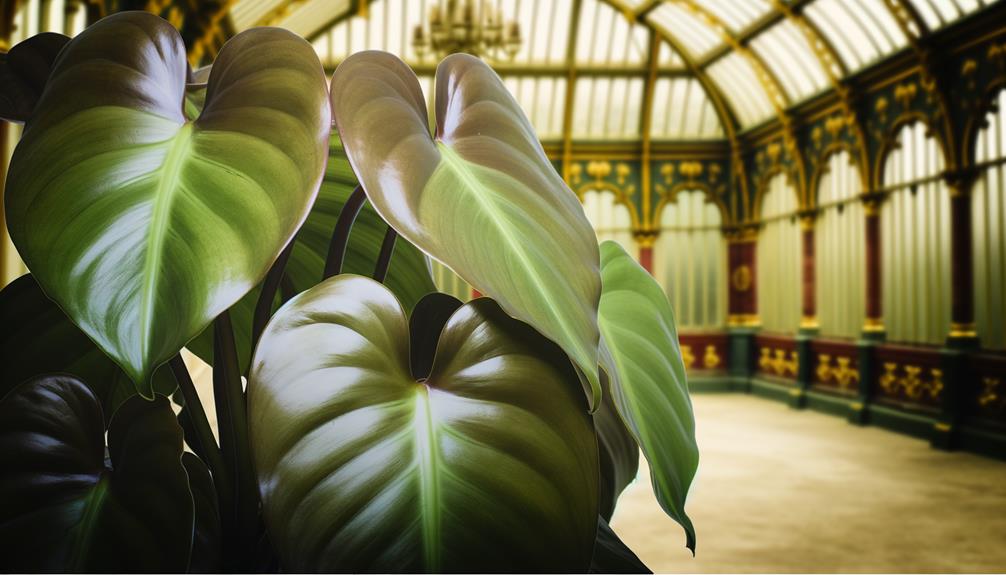
In the field of horticulture, understanding the unique characteristics and cultivation requirements of diverse plant species is fundamental. This discipline encompasses the science, art, technology, and business of plant cultivation. Horticulturists engage in detailed study and practice to enhance plant growth, health, and productivity.
Key aspects include:
- Taxonomy and identification: Recognizing plant species and their botanical classifications.
- Environmental conditions: Evaluating factors such as light, temperature, humidity, and soil composition.
- Propagation methods: Techniques for breeding, cloning, and propagating plants.
Philodendron micans, for instance, demands specific horticultural knowledge to thrive. Observing its native habitat informs the best conditions for indoor growth. Mastery in these areas guarantees the successful cultivation of a wide range of plants, including the increasingly popular Philodendron micans.
Cultivation Techniques
Effective cultivation of Philodendron Micans requires careful attention to soil composition, watering schedule, light exposure, and temperature control.
Best growth is achieved in well-draining, organic-rich substrates paired with consistent moisture levels, avoiding waterlogged conditions.
Additionally, maintaining a balance of indirect light and stable temperatures between 18-24°C is essential for healthy foliage development.
Soil and Watering Needs
Philodendron micans thrives in well-draining potting soil rich in organic matter, which helps maintain ideal moisture levels while preventing root rot. A balanced mix of peat, perlite, and vermiculite is recommended to guarantee aeration and moisture retention. Adequate watering is essential; the soil should remain consistently moist but not waterlogged.
Proper watering techniques involve thorough soaking, allowing excess water to drain, followed by a period of relative dryness. Observing these practices will promote healthy root development and growth, minimizing the risk of fungal infections.
- Watering Frequency: Water when the top inch of soil feels dry to the touch.
- Humidity: High humidity levels, typically above 60%, are advantageous.
- Drainage: Confirm pots have drainage holes to avoid water accumulation.
Light and Temperature
Ideal cultivation of Philodendron micans requires bright, indirect light to maintain its vibrant foliage, while direct sunlight should be avoided to prevent leaf scorch. Best growth is achieved under filtered light conditions, mimicking its natural understory habitat.
The species thrives in temperatures ranging from 18°C to 24°C, with a relative humidity of 60-80%. Sudden temperature fluctuations can stress the plant, leading to potential foliar damage or stunted growth. During colder months, maintaining a minimum temperature of 15°C is essential to prevent chilling injury.
Additionally, ensuring adequate air circulation helps mitigate fungal infections and pest infestations. For indoor cultivation, positioning the plant near east or north-facing windows is recommended to balance light intensity and temperature regulation.
Common Varieties
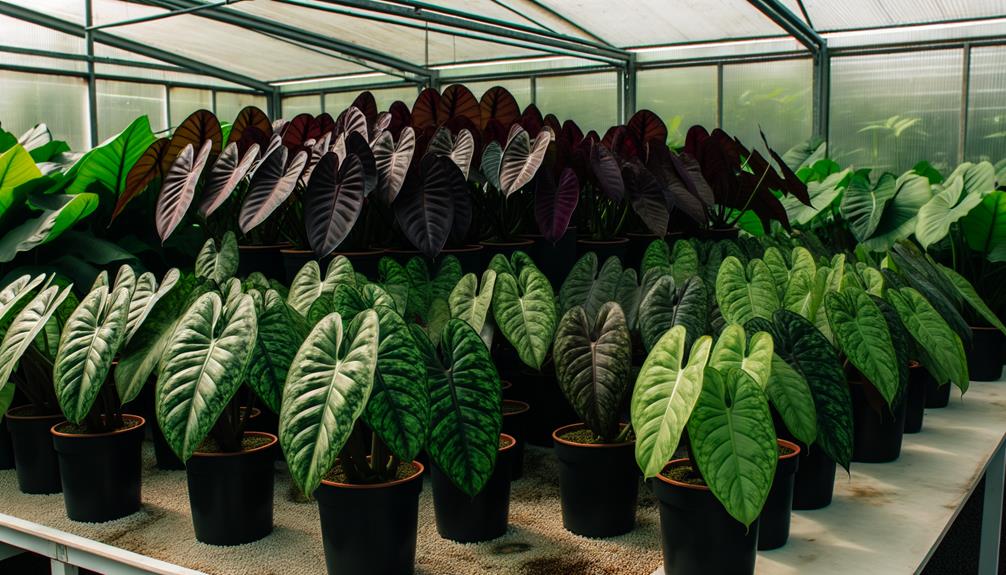
Among the common varieties of Philodendron micans, several exhibit unique morphological characteristics that distinguish them from other philodendron species. These varieties are highly prized for their distinctive features, such as the velvety texture of their foliage, which sets them apart in the horticultural community. Particularly, the following varieties stand out:
- Philodendron hederaceum var. micans: Renowned for its heart-shaped leaves with a velvety sheen and vibrant green hue.
- Philodendron micans 'Lime': Features striking lime-green foliage that provides a vivid contrast to the typical dark green of the species.
- Philodendron micans 'Velvet': Distinguished by its exceptionally soft, velvety leaves, this variety adds a luxurious texture to any plant collection.
These varieties underscore the genetic diversity within Philodendron micans.
Care Tips
Proper care of Philodendron micans requires a thorough understanding of its specific requirements for light, water, humidity, and soil composition. This species thrives in bright, indirect light and needs a well-draining, peat-based soil mix. Water the plant when the top inch of soil becomes dry, guaranteeing thorough drainage to prevent root rot. High humidity levels, ideally between 60-70%, are beneficial for best growth.
| Parameter | Ideal Condition | Notes |
|---|---|---|
| Light | Bright, indirect light | Avoid direct sunlight |
| Watering | Moderate | Allow top 1 inch to dry |
| Humidity | 60-70% | Use a humidifier if necessary |
| Soil Composition | Well-draining, peat-based | Promotes aeration and drainage |
| Temperature | 65-75°F (18-24°C) | Avoid cold drafts |
Regular monitoring and adjustments will promote a healthy Philodendron micans.
Conclusion
The Philodendron micans, a verdant jewel from the heart of Central and South America's tropical forests, represents the intricate tapestry of nature's artistry. Its discovery and subsequent botanical classification illuminate the ceaseless quest for understanding biodiversity.
The plant's introduction to horticulture and the refinement of its cultivation techniques symbolize humanity's desire to harmonize with the natural world. Through meticulous care, the Philodendron micans thrives, embodying the delicate balance between scientific curiosity and nature's intricate design.

